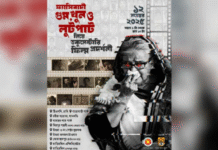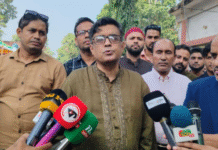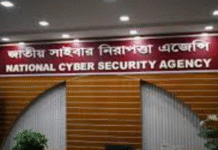What has ‘development’ given the people?
 Many stress the need for the government’s continuity, reasoning that no government can fully complete all the projects that it takes up in just a five-year term. And there are many projects linked to projects planned for the future too. When governments change, many projects of the previous government are simply left unfinished. Plans change.
Many stress the need for the government’s continuity, reasoning that no government can fully complete all the projects that it takes up in just a five-year term. And there are many projects linked to projects planned for the future too. When governments change, many projects of the previous government are simply left unfinished. Plans change.
The government led by Awami League has been at the helm for the past 10 years and is back in the driving seat for another five. Its main slogan is ‘development’. There has been a lot of infrastructure development in Dhaka city and all over the country. There are plans for multi-lane roads, flyovers, bridges, tunnels, a nuclear power plant, a deep seaport and so many more projects. ‘Development’ is on. But are we reaping the benefits? That’s a million-dollar question. Are these projects being planned carefully, or just taken up for the sake of ‘development’? Does development mean infrastructure, or something much bigger?
Take Dhaka city for instance. Over the past 10 years, two flyovers have been constructed in Dhaka. These flyovers have covered up many roads below. Has commuting been made any easier for the citizens of the city? Statistics don’t say so. According to the World Bank, 11 years ago the average speed of vehicles in Dhaka city was 21km/hr. Now it is 7km/hr. People can walk at 5km/hr. So no matter what development the government may be carrying out, the question is whether the people are benefitting from it or not.
Putting aside World Bank figures, what does public experience tell us? How many hours does it take to cover a distance of 15km in the city? The Dhaka-Chottogram highway has been made four-lane. The other day a person posted on Facebook that it took 12 hours to get to Dhaka from Chittagong by road. How long would it take before the four-lane highway? It is much worse than before. Perhaps it is only in the power sector where the people have found some relief.
If the benefits don’t reach the people, what does that development mean? There are so many examples around the world of how transport systems are planned, how a city is planned, how it is managed, how civic amenities are ensured and how all this is planned. There are many examples too of how unplanned cities have been turned around and changed, how civil amenities have been ensured in these cities. It shouldn’t been such a mammoth task to solve our problems. There are many examples all round. These tasks may be time-consuming but can be accomplished if carried out in a planned manner. None of the projects being undertaken at present, none of the infrastructure being constructed, seem to be planned in any manner.
There’s the Maghbazar-Mouchak flyover. It now takes inordinately long for those who are traveling from Maghbazar to Bangla Motor, to cross the intersection. It is just as if ‘development’ is enough, responsibility be damned. It doesn’t seem to matter if things have been made easier for the people or not. The roads beneath the flyovers are simply dead and discarded. Broad roads are narrow and have become garbage dumps.
Look at the road below the Maghbazar-Mouchak flyover, it is garbage dump as well as a chaotic market place where chickens are being slaughtered and sold. Fish are being cleaned, cut up and sold. If the flyovers are development, what’s up below them? It’s a travesty!
These flyovers just emphasise the fact that our planning is not at all up-to-date or forward-looking. In developed countries, the flyovers are basically built towards the entrance or exit of a city so the traffic can enter or leave the city unhindered. Flyovers within a city means the death of roads.
There is no coordination in the development being carried out. There is no alternative but to cancel the Bus Rapid Transit (BRT) of the Tejgaon-Maghbazar and Rampur Mouchak route because of the Mouchak-Maghbazar flyover. That means when this flyover was planned, no one bothered to think of the BRT. Because of the Mayor Hanif flyover, the metro-rail can’t be taken beyond Jatrabari.
Development means development in planning too. Planning needs farsightedness, means knowing how to prioritise projects. Development projects worth billions of taka are easily approved, while the embankments can’t be repaired properly due to inadequate fund allocation. Surely it is more important for people to have pure drinking water than to have these glamorous mega projects.
A question has arisen as to whether Payra seaport can be kept operational due to the heavy siltation. International surveys say it will be a difficult task. Given the location of the port, siltation is inevitable. It will take 80 billion to 100 billion taka to remove the silt, that too with the port being closed down. The port is being constructed with no thought of the outcome. Our development is all chaotic.
Then there is the matter of management, of running the financial and banking sectors, of governance. Economist Wahiduddin Mahmud has said that Bangladesh’s banking sector was of global standards at one point of time, but now has fallen back. Don’t we need to develop this sector? Why have we fallen in standard?
The pace of poverty alleviation has slackened too and inequity has increased. Regional inequity has increased too. Is just putting up infrastructure enough? There may be flyovers, there may be four-lane highways, but without proper management, what sort of development is this?
Unplanned development is not development. The projects must be justified. Development must being benefits to the people. There has to be coordination so each project is multipurpose. Management must be developed. Without a holistic approach to development, the people will simply remain deprived.
* AKM Zakaria is deputy editor of Prothom Alo and can be reached at akmzakaria@gmail.com
This piece appeared in the print edition of Prothom Alo and has been rewritten in English by Ayesha Kabir









